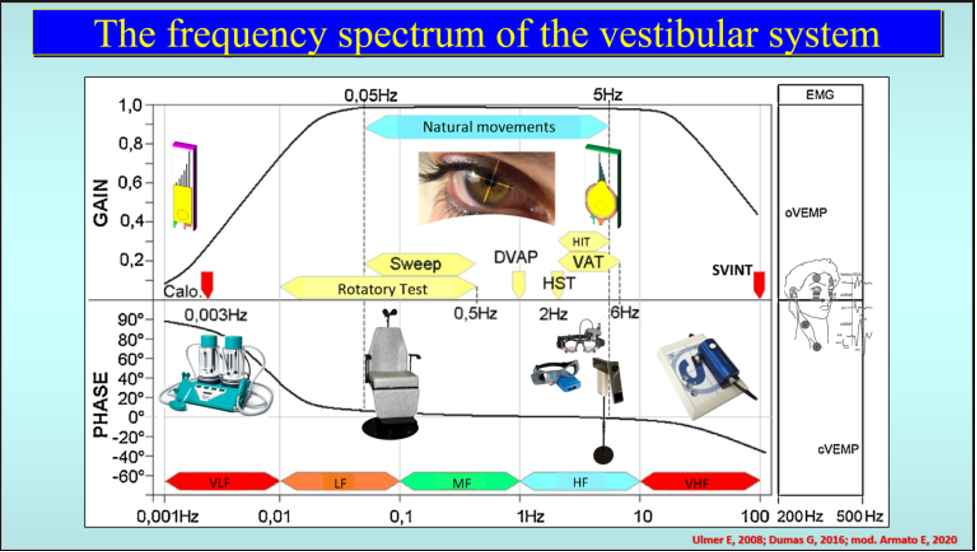Question
What is the frequency spectrum of the vestibular system?
Answer
The anatomical-functional complexity of the vestibular system closely interacts with the visual system and the central nervous system. Specific stimuli are the angular and linear acceleration (including gravitational) of the head, which act respectively on the vestibular receptors of the ampullae in the semicircular canals (lateral, posterior, and anterior) and the macules (utricle and saccule).
Both canal and macular receptors are divided into two types having important anatomical and functional differences: type I cells (phasic or irregular discharge receptors) and type II cells (tonic or regular discharge receptors). This distinction is fundamental because their lesion is clinically expressed differently, and they are evaluated with different tests.
The information collected through the vestibular nerve reaches the vestibular nuclei and continues towards the oculomotor nuclei. The spinal cord and higher centers reach the cerebellum directly. There is also efferent control at the level of the vestibular receptors.
It is necessary to consider the labyrinth as an organ that responds in frequency, like the cochlea. While the cochlea responds in different sectors depending on the frequency of the sound, the vestibule responds to different stimulation frequencies of the head. This is less intuitive, but it can be easily illustrated with an example. Let's imagine making the following continuous movement of the head: we start from the straight head position, then we turn to the right, we turn to the left, and then we stop in the starting straight position. The point of departure and arrival are the same. It is, therefore, a sinusoidal movement, in which the time necessary to complete the entire cycle is called period (T), which is measured in seconds. The frequency is the inverse of the period and is measured in Hz (f = 1 / T ).
We will be able to distinguish various frequency ranges of stimulation of the labyrinth: very low frequencies (0.001-0.01 Hz), low frequencies (0.01-0.1 Hz), medium frequencies (0.1-1 Hz), high frequencies (1-10 Hz) and very high frequencies (10-100 Hz).
The tonic receptors come into action at the very low-low-medium frequencies, while the phasic receptors are activated at the high and very high frequencies.
The band of natural movements of the head is between 0.05Hz and 5Hz, an area in which the gain approaches unity and the phase has a value close to 0. For lower frequencies, the gain decreases, and the phase takes positive values. For higher frequencies, the gain decreases, and the phase assumes negative values.
In such a complex system, it is difficult for a single test to provide all the information necessary to assess the functional conditions of the vestibule as a whole.
The different types of tests for evaluating each frequency range:
- Bithermal caloric tests are suitable for the evaluation of very low frequencies and express the function of tonic receptors;
- Kinetic tests are suitable for the evaluation of low and medium frequencies and express the function of tonic receptors;
- HST and HIT are suitable for the evaluation of high frequencies and express the function of phasic receptors;
- The Vibratory test is suitable for evaluating very high frequencies and expresses the function of the phasic receptors.
Beyond the very high frequencies, we enter the domain of vestibular evoked potentials, that is, of oVEMPs and cVEMPs.
From all this follows the selectivity of information that each vestibular test provides. For this reason, there may be apparent contradictions in the results of the tests applied to the individual patient. For example, the dissociation between bithermal heat tests and HIT is known in subjects affected by endolymphatic hydrops The first is altered in the initial stages of the disease and the normal second.
The choice of tests to be performed on each patient is in relation to the diagnostic suspicion that one has and that one wants to confirm.

Figure 1. The frequency spectrum of the vestibular system.
To learn more about Inventis, please visit their Corporate Partner page on AudiologyOnline or inventis.it.

